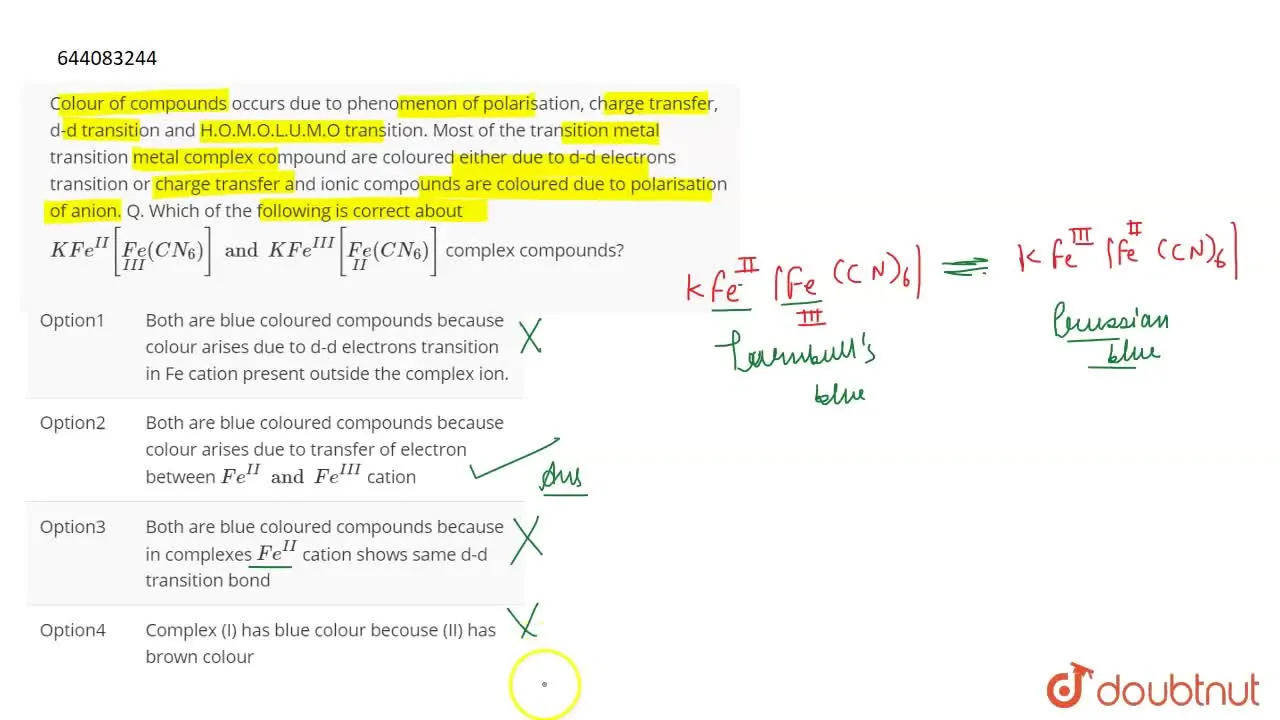Colour of compounds occurs due to phenomenon of polarisation, charge transfer, d-d transition and H.O.M.O.L.U.M.O transition. Most of the transition metal transition metal complex compound are coloured either due to d-d electrons transition or charge transfer and ionic compounds are coloured due to polarisation of anion. Q. Which of the following is correct about KFeII[FeIII(CN6)]andKFeIII[FeII(CN6)] complex compounds?
Both are blue coloured compounds because colour arises due to d-d electrons transition in Fe cation present outside the complex ion.
Both are blue coloured compounds because colour arises due to transfer of electron between FeIIandFeIII cation
Both are blue coloured compounds because in complexes FeII cation shows same d-d transition bond
Complex (I) has blue colour becouse (II) has brown colour
The correct Answer is:B
Step by step video & image solution for Colour of compounds occurs due to phenomenon of polarisation, charge transfer, d-d transition and H.O.M.O.L.U.M.O transition. Most of the transition metal transition metal complex compound are coloured either due to d-d electrons transition or charge transfer and ionic compounds are coloured due to polarisation of anion. Q. Which of the following is correct about KFe^(II)[underset(III)(Fe)(CN_(6))] and KFe^(III)[underset(II)(Fe)(CN_(6))] complex compounds? by Chemistry experts to help you in doubts & scoring excellent marks in Class 12 exams.
Related Playlists
- BOOK - VK JAISWAL ENGLISHCHAPTER - CHEMICAL BONDING (ADVANCED)EXERCISE - ONE OR MORE ANSWER IS/ARE CORRECT78videos
CHEMICAL BONDING (ADVANCED)
- BOOK - VK JAISWAL ENGLISHCHAPTER - CHEMICAL BONDING (ADVANCED)EXERCISE - MATCH THE COLUMN21videos
CHEMICAL BONDING (ADVANCED)
- BOOK - VK JAISWAL ENGLISHCHAPTER - CHEMICAL BONDING (ADVANCED)EXERCISE - Level 2150videos
CHEMICAL BONDING (ADVANCED)
- BOOK - VK JAISWAL ENGLISHCHAPTER - CHEMICAL BONDING (BASIC)EXERCISE - SUBJECTIVE PROBLEMS54videos
CHEMICAL BONDING (BASIC)
Similar Questions
Colour of compounds occurs due to phenomenon of polarisation, charge transfer, d-d transition and H.O.M.O.L.U.M.O transition. Most of the transition metal transition metal complex compound are coloured either due to d-d electrons transition or charge transfer and ionic compounds are coloured due to polarisation of anion. Q. If MCl4 salt is white, then comment on colour of its iodine salt.
View SolutionTransition metal compounds are usually coloured This is due to the electronic transition .
View SolutionWhich of the following complexes may be coloured due to d-d transition ?
View SolutionGenerally transition elements and their salts are coloured due to the presence of unpaired electrons in metal ions. Which of the following compounds are coloured?
View SolutionGenerally transition elements form coloured salts due to the presence of unpaired electrons. Which of the following compounds will be coloured in the solid state ?
View SolutionGenerally transition elements from coloured salts due to the presence of unpaired electrons. Which of the following compounds will be coloured in solid state?
View SolutionGenerally transition elements form coloured salts due to the presence of unpaired electrons. Which of the following compounds will be coloured in the solid state ?
View SolutionWhat are transition elements ? Explain that transition metal compounds are generally:
(a) coloured
(b) act as catalysts
(c) show variable oxidation states.
(d) form complexes
(e) have high m.pt. and b.pt.View SolutionAssertion: CuSO4⋅5H2OandFeSO4⋅7H2O are blue and green colour compounds respectively.
Reason: Both compounds have their specific colour due to phenomenon of polarisation of anion.View SolutionAssertion: CuSO4⋅5H2OandFeSO4⋅7H2O are blue and green colour compounds respectively.
Reason: Both compounds have their specific colour due to phenomenon of polarisation of anion.View Solution


